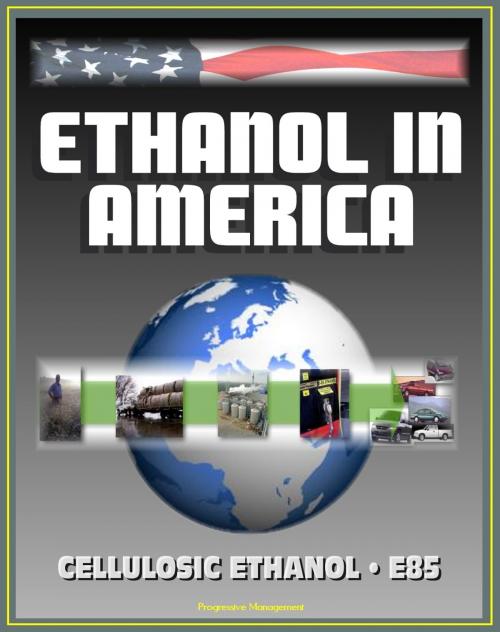Ethanol in America: The Growth of the Cellulosic Ethanol Industry and the DOE Handbook on E85 - The Alternative Fuel for Advanced Vehicles
Nonfiction, Science & Nature, Technology, Power Resources| Author: | Progressive Management | ISBN: | 9781476247441 |
| Publisher: | Progressive Management | Publication: | April 25, 2012 |
| Imprint: | Smashwords Edition | Language: | English |
| Author: | Progressive Management |
| ISBN: | 9781476247441 |
| Publisher: | Progressive Management |
| Publication: | April 25, 2012 |
| Imprint: | Smashwords Edition |
| Language: | English |
Here is unique information about ethanol, cellulosic ethanol, and E85 fuels from the DOE. Contents: Part 1: Handbook for Handling, Storing, and Dispensing E85; Part 2: Understanding the Growth of the Cellulosic Ethanol Industry.
E85 Handbook: This document serves as a guide for blenders, distributors, sellers, and users of E85 as an alternative motor fuel. It provides basic information on the proper and safe use of E85 and offers supporting technical and policy references. E85 is an alternative motor fuel authorized by the Energy Policy Act (EPAct) of 1992, Section 301(2). As defined by EPAct, E85 is composed of 85% fuel grade ethanol and 15% hydrocarbons in the gasoline boiling range. Ethanol is a renewable, domestically produced fuel that can be made from grains, such as corn or wheat, or from biomass or cellulose sources, such as prairie grass and agricultural, forestry, or municipal waste matter. Several research studies show that E85 has the potential to substantially reduce petroleum fuel use and greenhouse gas emissions (GHGs). Driven by increasing gasoline prices, the market for E85 is growing. With consumer demand for alternative fuel vehicles (AFVs) increasing, auto manufacturers are working to produce more flexible fuel vehicles (FFVs), which are capable of operating on E85 or gasoline or a combination of the two. As of May 2010, there were 8.35 million FFVs on U.S. roads, and automakers were planning to produce several million more each year. FFVs are available in most vehicle classes, including sedans, minivans, trucks, and sport utility vehicles. The number of E85 fueling stations is growing rapidly nationwide. As of June 2010, there were 2,051 retail stations (out of 162,000 nationwide) offering E85 across the country. Several key factors affecting E85 growth and acceptance were recently addressed. The U.S. Environmental Protection Agency (EPA) issued a guidance document to states defining a process by which they could determine whether "Stage II" gasoline vapor recovery equipment would be required for new E85 pumps. In October 2007, Underwriters Laboratories, Inc., (UL) established standardized testing procedures for E85 fuel dispensers that address the unique properties of alcohol fuels when blended with gasoline. This testing standard (UL Subject 87A) was updated in August 2009. In addition, UL announced equipment listed for E85 use in June 2010.
Cellulosic Ethanol Industry: This report identifies, outlines, and documents a set of plausible scenarios for producing significant quantities of lignocellulosic ethanol in 2017. These scenarios can provide guidance for setting government policy and targeting government investment to the areas with greatest potential impact. A prototype version of the Biomass Scenario Model (BSM) was used to develop the scenarios. The analysis underlying the scenario-generation exercise focuses on understanding the impact of two types of proposed government policies on the deployment of cellulosic biofuels technologies: Policies focused on reducing operating costs associated with cellulosic ethanol production. These policies include payments to feedstock producers and subsidies associated with production of cellulosic ethanol. Policies focused on reducing capital costs associated with cellulosic ethanol production. These policies include capital subsidies for construction of full-scale cellulosic ethanol production plants.
Here is unique information about ethanol, cellulosic ethanol, and E85 fuels from the DOE. Contents: Part 1: Handbook for Handling, Storing, and Dispensing E85; Part 2: Understanding the Growth of the Cellulosic Ethanol Industry.
E85 Handbook: This document serves as a guide for blenders, distributors, sellers, and users of E85 as an alternative motor fuel. It provides basic information on the proper and safe use of E85 and offers supporting technical and policy references. E85 is an alternative motor fuel authorized by the Energy Policy Act (EPAct) of 1992, Section 301(2). As defined by EPAct, E85 is composed of 85% fuel grade ethanol and 15% hydrocarbons in the gasoline boiling range. Ethanol is a renewable, domestically produced fuel that can be made from grains, such as corn or wheat, or from biomass or cellulose sources, such as prairie grass and agricultural, forestry, or municipal waste matter. Several research studies show that E85 has the potential to substantially reduce petroleum fuel use and greenhouse gas emissions (GHGs). Driven by increasing gasoline prices, the market for E85 is growing. With consumer demand for alternative fuel vehicles (AFVs) increasing, auto manufacturers are working to produce more flexible fuel vehicles (FFVs), which are capable of operating on E85 or gasoline or a combination of the two. As of May 2010, there were 8.35 million FFVs on U.S. roads, and automakers were planning to produce several million more each year. FFVs are available in most vehicle classes, including sedans, minivans, trucks, and sport utility vehicles. The number of E85 fueling stations is growing rapidly nationwide. As of June 2010, there were 2,051 retail stations (out of 162,000 nationwide) offering E85 across the country. Several key factors affecting E85 growth and acceptance were recently addressed. The U.S. Environmental Protection Agency (EPA) issued a guidance document to states defining a process by which they could determine whether "Stage II" gasoline vapor recovery equipment would be required for new E85 pumps. In October 2007, Underwriters Laboratories, Inc., (UL) established standardized testing procedures for E85 fuel dispensers that address the unique properties of alcohol fuels when blended with gasoline. This testing standard (UL Subject 87A) was updated in August 2009. In addition, UL announced equipment listed for E85 use in June 2010.
Cellulosic Ethanol Industry: This report identifies, outlines, and documents a set of plausible scenarios for producing significant quantities of lignocellulosic ethanol in 2017. These scenarios can provide guidance for setting government policy and targeting government investment to the areas with greatest potential impact. A prototype version of the Biomass Scenario Model (BSM) was used to develop the scenarios. The analysis underlying the scenario-generation exercise focuses on understanding the impact of two types of proposed government policies on the deployment of cellulosic biofuels technologies: Policies focused on reducing operating costs associated with cellulosic ethanol production. These policies include payments to feedstock producers and subsidies associated with production of cellulosic ethanol. Policies focused on reducing capital costs associated with cellulosic ethanol production. These policies include capital subsidies for construction of full-scale cellulosic ethanol production plants.















